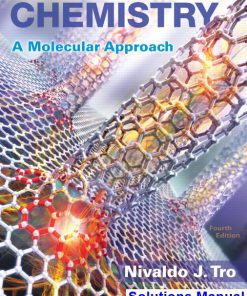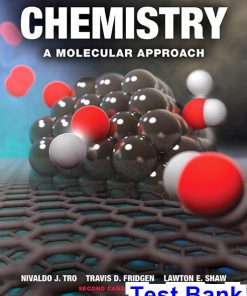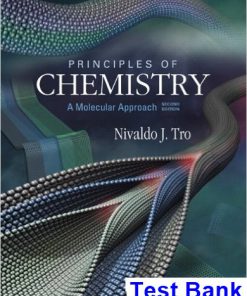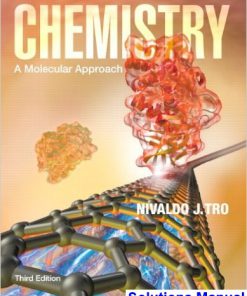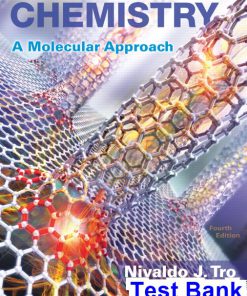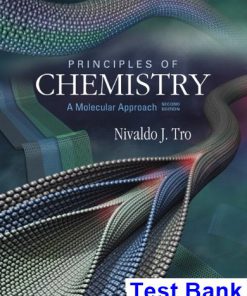Chemistry A Molecular Approach Canadian 1st Edition Tro Test Bank
$50.00 Original price was: $50.00.$26.50Current price is: $26.50.
Chemistry A Molecular Approach Canadian 1st Edition Tro Test Bank.
This is completed downloadable of Chemistry A Molecular Approach Canadian 1st Edition Tro Test Bank
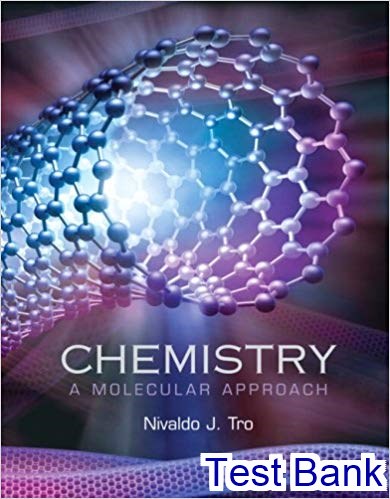
Product Details:
- ISBN-10 : 0135115213
- ISBN-13 : 978-0135115213
- Author: Nivaldo J. Tro
This innovative text explains difficult concepts in a relevant, student-oriented manner. Chemistry is presented visually through multi-level images–macroscopic, molecular and symbolic representations–helping you see the connections among the formulas (symbolic), the world around you (macroscopic), and the atoms and molecules that make up the world (molecular). Among other revisions, the Second Edition offers a crisp new design, adds more challenging problems, and significantly revises coverage of electrochemistry. This is just the standalone book if you want the book/access kit order: 0321706153 / 9780321706157 Chemistry: A Molecular Approach with MasteringChemistry(R) Package consists of: 0321651782 / 9780321651785 Chemistry: A Molecular Approach 0321695348 / 9780321695345 MasteringChemistry(R) with Pearson eText Student Access Kit for Chemistry: A Molecular Approach
Table of Content:
Chapter 1 Matter, Measurement, and Problem Solving 1.1 Atoms and Molecules 1.2 The Scientific Approach to Knowledge The Nature of Science: Thomas S. Kuhn and Scientific Revolutions 1.3 The Classification of Matter The States of Matter: Solid, Liquid, and Gas Classifying Matter According to Its Composition: Elements, Compounds, and Mixtures Separating Mixtures 1.4 Physical and Chemical Changes and Physical and Chemical Properties 1.5 Energy: A Fundamental Part of Physical and Chemical Change 1.6 The Units of Measurement The Standard Units The Meter: A Measure of Length The Kilogram: A Measure of Mass The Second: A Measure of Time The Kelvin: A Measure of Temperature Prefix Multipliers Derived Units: Volume and Density Calculating Density Chemistry and Medicine: Bone Density 1.7 The Reliability of a Measurement Counting Significant Figures Exact Numbers Significant Figures in Calculations Precision and Accuracy Chemistry in Your Day: Integrity in Data Gathering 1.8 Solving Chemical Problems Converting from One Unit to Another General Problem-Solving Strategy Units Raised to a Power Order of Magnitude Estimations Problems Involving an Equation Chapter in Review Key Terms Key Concepts Key Equations and Relationships Key Skills Exercises Review Questions Problems by Topic Cumulative Problems Challenge Problems Conceptual Problems Chapter 2 Atoms and Elements 2.1 Imaging and Moving Individual Atoms 2.2 Early Ideas about the Building Blocks of Matter 2.3 Modern Atomic Theory and the Laws That Led to It The Law of Conservation of Mass The Law of Definite Proportions The Law of Multiple Proportions John Dalton and the Atomic Theory Chemistry in Your Day: Atoms and Humans 2.4 The Discovery of the Electron Cathode Rays Millikan¿s Oil Drop Experiment: The Charge of the Electron 2.5 The Structure of the Atom 2.6 Subatomic Particles: Protons, Neutrons, and Electrons in Atoms Elements: Defined by Their Numbers of Protons Isotopes: When the Number of Neutrons Varies Ions: Losing and Gaining Electrons 2.7 Finding Patterns: The Periodic Law and the Periodic Table Ions and the Periodic Table Chemistry and Medicine: The Elements of Life 2.8 Atomic Mass: The Average Mass of an Element¿s Atoms Mass Spectrometry: Measuring the Mass of Atoms and Molecules 2.9 Molar Mass: Counting Atoms by Weighing Them The Mole: A Chemist¿s ¿Dozen¿ Converting between Number of Moles and Number of Atoms Converting between Mass and Amount (Number of Moles) Chapter in Review Key Terms Key Concepts Key Equations and Relationships Key Skills Exercises Review Questions Problems by Topic Cumulative Problems Challenge Problems Conceptual Problems Chapter 3 Molecules, Compounds, and Chemical Equations 3.1 Hydrogen, Oxygen, and Water 3.2 Chemical Bonds 3.3 Representing Compounds: Chemical Formulas and Molecular Models Types of Chemical Formulas Molecular Models 3.4 An Atomic-Level View of Elements and Compounds 3.5 Ionic Compounds: Formulas and Names Writing Formulas for Ionic Compounds Naming Ionic Compounds Naming Binary Ionic Compounds Naming Binary Ionic Compounds Containing a Metal That Forms More than One Kind of Cation Naming Ionic Compounds Containing Polyatomic Ions Hydrated Ionic Compounds 3.6 Molecular Compounds: Formulas and Names Naming Molecular Compounds Naming Acids Naming Binary Acids Naming Oxyacids Chemistry in the Environment: Acid Rain 3.7 Formula Mass and the Mole Concept for Compounds Molar Mass of a Compound Using Molar Mass to Count Molecules by Weighing 3.8 Composition of Compounds Mass Percent Composition as a Conversion Factor Conversion Factors from Chemical Formulas Chemistry and Medicine: Methylmercury in Fish 3.9 Determining a Chemical Formula from Experimental Data Calculating Molecular Formulas for Compounds Combustion Analysis 3.10 Writing and Balancing Chemical Equations How to Write Balanced Chemical Equations 3.11 Organic Compounds Hydrocarbons Functionalized Hydrocarbons Chapter in Review Key Terms Key Concepts Key Equations and Relationships Key Skills Exercises Review Questions Problems by Topic Cumulative Problems Challenge Problems Conceptual Problems Chapter 4 Chemical Quantities and Aqueous Reactions 4.1 Global Warming and the Combustion of Fossil Fuels 4.2 Reaction Stoichiometry: How Much Carbon Dioxide? Making Pizza: The Relationship among Ingredients Making Molecules: Mole-to-Mole Conversions Making Molecules: Mass-to-Mass Conversions 4.3 Limiting Reactant, Theoretical Yield, and Percent Yield Limiting Reactant, Theoretical Yield, and Percent Yield from Initial Reactant Masses Chemistry in the Environment: MTBE in Gasoline 4.4 Solution Concentration and Solution Stoichiometry Solution Concentration Using Molarity in Calculations Solution Dilution Solution Stoichiometry 4.5 Types of Aqueous Solutions and Solubility Electrolyte and Nonelectrolyte Solutions The Solubility of Ionic Compounds 4.6 Precipitation Reactions 4.7 Representing Aqueous Reactions: Molecular, Ionic, and Complete Ionic Equations 4.8 Acid¿Base and Gas-Evolution Reactions Acid¿Base Reactions Acid¿Base Titrations Gas-Evolution Reactions 4.9 Oxidation¿Reduction Reactions Oxidation States Identifying Redox Reactions Chemistry in Your Day: Bleached Blonde Combustion Reactions Chapter in Review Key Terms Key Concepts Key Equations and Relationships Key Skills Exercises Review Questions Problems by Topic Cumulative Problems Challenge Problems Conceptual Problems Chapter 5 Gases 5.1 Water from Wells: Atmospheric Pressure at Work 5.2 Pressure: The Result of Molecular Collisions Pressure Units The Manometer: A Way to Measure Pressure in the Laboratory Chemistry and Medicine: Blood Pressure 5.3 The Simple Gas Laws: Boyle¿s Law, Charles¿s Law, and Avogadro¿s Law Boyle¿s Law: Volume and Pressure Chemistry in Your Day: Extralong Snorkels Charles¿s Law: Volume and Temperature Avogadro¿s Law: Volume and Amount (in Moles) 5.4 The Ideal Gas Law 5.5 Applications of the Ideal Gas Law: Molar Volume, Density, and Molar Mass of a Gas Molar Volume at Standard Temperature and Pressure Density of a Gas Molar Mass of a Gas 5.6 Mixtures of Gases and Partial Pressures Deep-Sea Diving and Partial Pressure Collecting Gases over Water 5.7 Gases in Chemical Reactions: Stoichiometry Revisited Molar Volume and Stoichiometry 5.8 Kinetic Molecular Theory: A Model for Gases Kinetic Molecular Theory and the Ideal Gas Law Temperature and Molecular Velocities 5.9 Mean Free Path, Diffusion, and Effusion of Gases 5.10 Real Gases: The Effects of Size and Intermolecular Forces The Effect of the Finite Volume of Gas Particles The Effect of Intermolecular Forces Van der Waals¿ Equation Real Gases 5.11 Chemistry of the Atmosphere: Air Pollution and Ozone Depletion Air Pollution Ozone Depletion Chapter in Review Key Terms Key Concepts Key Equations and Relationships Key Skills Exercises Review Questions Problems by Topic Cumulative Problems Challenge Problems Conceptual Problems Chapter 6 Thermochemistry 6.1 Light the Furnace: The Nature of Energy and Its Transformations The Nature of Energy: Key Definitions Units of Energy 6.2 The First Law of Thermodynamics: There Is No Free Lunch Chemistry in Your Day: Redheffer¿s Perpetual Motion Machine Internal Energy 6.3 Quantifying Heat and Work Heat Work: Pressure¿Volume Work 6.4 Measuring ?E for Chemical Reactions: Constant-Volume Calorimetry 6.5 Enthalpy: The Heat Evolved in a Chemical Reaction at Constant Pressure Exothermic and Endothermic Processes: A Molecular View Stoichiometry Involving ?H: Thermochemical Equations 6.6 Constant-Pressure Calorimetry: Measuring ?Hrxn 6.7 Relationships Involving ?Hrxn 6.8 Enthalpies of Reaction from Standard Heats of Formation Standard States and Standard Enthalpy Changes Calculating the Standard Enthalpy Change for a Reaction 6.9 Energy Use and the Environment Environmental Problems Associated with Fossil Fuel Use Chemistry in the Environment: Renewable Energy Chapter in Review Key Terms Key Concepts Key Equations and Relationships Key Skills Exercises Review Questions Problems by Topic Cumulative Problems Challenge Problems Conceptual Problems Chapter 7 The Quantum-Mechanical Model of the Atom 7.1 Quantum Mechanics: A Theory That Explains the Behavior of the Absolutely Small 7.2 The Nature of Light The Wave Nature of Light The Electromagnetic Spectrum Chemistry and Medicine: Radiation Treatment for Cancer Interference and Diffraction The Particle Nature of Light 7.3 Atomic Spectroscopy and the Bohr Model Chemistry in Your Day: Atomic Spectroscopy, a Bar Code for Atoms 7.4 The Wave Nature of Matter: The de Broglie Wavelength, the Uncertainty Principle, and Probability The de Broglie Wavelength The Uncertainty Principle Indeterminacy and Probability Distribution Maps 7.5 Quantum Mechanics and the Atom Solutions to the Schrödinger Equation for the Hydrogen Atom Atomic Spectroscopy Explained 7.6 The Shapes of Atomic Orbitals p Orbitals (l = 1) d Orbitals (l = 2) f Orbitals (l = 3) Chapter in Review Key Terms Key Concepts Key Equations and Relationships Key Skills Exercises Review Questions Problems by Topic Cumulative Problems Challenge Problems Conceptual Problems Chapter 8 Periodic Properties of the Elements 8.1 Nerve Signal Transmission 8.2 The Development of the Periodic Table 8.3 Electron Configurations: How Electrons Occupy Orbitals Electron Spin and the Pauli Exclusion Principle Sublevel Energy Splitting in Multielectron Atoms Electron Configurations for Multielectron Atoms 8.4 Electron Configurations, Valence Electrons, and the Periodic Table Orbital Blocks in the Periodic Table Writing an Electron Configuration for an Element from Its Position in the Periodic Table The Transition and Inner Transition Elements 8.5 The Explanatory Power of the Quantum-Mechanical Model 8.6 Periodic Trends in the Size of Atoms and Effective Nuclear Charge Effective Nuclear Charge Atomic Radii and the Transition Elements 8.7 Ions: Electron Configurations, Magnetic Properties, Ionic Radii, and Ionization Energy Electron Configurations and Magnetic Properties of Ions Ionic Radii Ionization Energy Trends in First Ionization Energy Exceptions to Trends in First Ionization Energy Trends in Second and Successive Ionization Energies 8.8 Electron Affinities and Metallic Character Electron Affinity Metallic Character 8.9 Some Examples of Periodic Chemical Behavior: The Alkali Metals, the Halogens, and the Noble Gases The Alkali Metals (Group 1A) The Halogens (Group 7A) Chemistry and Medicine: Potassium Iodide in Radiation Emergencies The Noble Gases (Group 8A) Chapter in Review Key Terms Key Concepts Key Equations and Relationships Key Skills Exercises Review Questions Problems by Topic Cumulative Problems Challenge Problems Conceptual Problems Chapter 9 Chemical Bonding I: Lewis Theory 9.1 Bonding Models and AIDS Drugs 9.2 Types of Chemical Bonds 9.3 Representing Valance Electrons with Dots 9.4 Ionic Bonding: Lewis Structures and Lattice Energies Ionic Bonding and Electron Transfer Lattice Energy: The Rest of the Story The Born¿Haber Cycle Trends in Lattice Energies: Ion Size Trends in Lattice Energies: Ion Charge Ionic Bonding: Models and Reality Chemistry and Medicine: Ionic Compounds as Drugs 9.5 Covalent Bonding: Lewis Structure Single Covalent Bonds Double and Triple Covalent Bonds Covalent Bonding: Models and Reality 9.6 Electronegativity and Bond Polarity Electronegativity Bond Polarity, Dipole Moment, and Percent Ionic Character 9.7 Lewis Structures of Molecular Compounds and Polyatomic Ions Writing Lewis Structures for Molecular Compounds Writing Lewis Structures for Polyatomic Ions 9.8 Resonance and Formal Charge Resonance Formal Charge 9.9 Exceptions to the Octet Rule: Odd-Electron Species, Incomplete Octets, and Expanded Octets Odd-Electron Species Chemistry in the Environment: Free Radicals and the Atmospheric Vacuum Cleaner Incomplete Octets Expanded Octets 9.10 Bond Energies and Bond Lengths Bond Energy Using Average Bond Energies to Estimate Enthalpy Changes for Reactions Bond Lengths Chemistry in the Environment: The Lewis Structure of Ozone 9.11 Bonding in Metals: The Electron Sea Model Chapter in Review Key Terms Key Concepts Key Equations and Relationships Key Skills Exercises Review Questions Problems by Topic Cumulative Problems Challenge Problems Conceptual Problems Chapter 10 Chemical Bonding II: Molecular Shapes, Valance Bond Theory, and Molecular Orbital Theory 10.1 Artificial Sweeteners: Fooled by Molecular Shape 10.2 VSEPR Theory: The Five Basic Shapes Two Electron Groups: Linear Geometry Three Electron Groups: Trigonal Planar Geometry Four Electron Groups: Tetrahedral Geometry Five Electron Groups: Trigonal Bipyramidal Geometry Six Electron Groups: Octahedral Geometry 10.3 VSEPR Theory: The Effect of Lone Pairs Four Electron Groups with Lone Pairs Five Electron Groups with Lone Pairs Six Electron Groups with Lone Pairs Summary of VSEPR theory 10.4 VSEPR Theory: Predicting Molecular Geometries Predicting the Shapes of Larger Molecules 10.5 Molecular Shape and Polarity Chemistry in Your Day: How Soap Works 10.6 Valence Bond Theory: Orbital Overlap as a Chemical Bond 10.7 Valence Bond Theory: Hybridization of Atomic Orbitals sp3 Hybridization sp2 Hybridization and Double Bonds Chemistry in Your Day: The Chemistry of Vision sp Hybridization and Triple Bonds sp3d and sp3d2 Hybridization Writing Hybridization and Bonding Schemes 10.8 Molecular Orbital Theory: Electron Delocalization Linear Combination of Atomic Orbitals (LCAO) Main Ideas in Applying LCAO¿MO Theory Period Two Homonuclear Diatomic Molecules Period Two Heteronuclear Diatomic Molecules Polyatomic Molecules Chapter in Review Key Terms Key Concepts Key Equations and Relationships Key Skills Exercises Review Questions Problems by Topic Cumulative Problems Challenge Problems Conceptual Problems Chapter 11 Liquids, Solids, and Intermolecular Forces 11.1 Climbing Geckos and Intermolecular Forces 11.2 Solids, Liquids, and Gases: A Molecular Comparison Changes between Phases 11.3 Intermolecular Forces: The Forces That Hold Condensed Phases Together Dispersion Force Dipole¿Dipole Force Hydrogen Bonding Ion¿Dipole Force Chemistry and Medicine: Hydrogen Bonding in DNA 11.4 Intermolecular Forces in Action: Surface Tension, Viscosity, and Capillary Action Surface Tension Viscosity Chemistry in Your Day: Viscosity and Motor Oil Capillary Action 11.5 Vaporization and Vapor Pressure The Process of Vaporization The Energetics of Vaporization Vapor Pressure and Dynamic Equilibrium Temperature Dependence of Vapor Pressure and Boiling Point The Clausius¿Clapeyron Equation The Critical Point: The Transition to an Unusual Phase of Matter 11.6 Sublimation and Fusion Sublimation Fusion Energetics of Melting and Freezing 11.7 Heating Curve for Water 11.8 Phase Diagrams The Major Features of a Phase Diagram Navigation within a Phase Diagram The Phase Diagrams of Other Substances 11.9 Water: An Extraordinary Substance Chemistry in the Environment: Water Pollution 11.10 Crystalline Solids: Determining Their Structure by X-Ray Crystallography 11.11 Crystalline Solids: Unit Cells and Basic Structures Closeest-Packed Structures 11.12 Crystalline Solids: The Fundamental Types Molecular Solids Ionic Solids Atomic Solids 11.13 Crystalline Solids: Band Theory Doping: Controlling the Conductivity of Semiconductors Chapter in Review Key Terms Key Concepts Key Equations and Relationships Key Skills Exercises Review Questions Problems by Topic Cumulative Problems Challenge Problems Conceptual Problems Chapter 12 Solutions 12.1 Thirsty Solutions: Why You Should Not Drink Seawater 12.2 Types of Solutions and Solubility Nature¿s Tendency toward Mixing: Entropy The Effect of Intermolecular Forces 12.3 Energetics of Solution Formation Aqueous Solutions and Heats of Hydration 12.4 Solution Equilibrium and Factors Affecting Solubility The Temperature Dependence of the Solubility of Solids Factors Affecting the Solubility of Gases in Water Chemistry in the Environment: Lake Nyos 12.5 Expressing Solution Concentration Molarity Molality Parts by Mass and Parts by Volume Chemistry in the Environment: The Dirty Dozen Mole Fraction and Mole Percent 12.6 Vapor Pressure of Solutions Ionic Solutes and Vapor Pressure Ideal and Nonideal Solutions 12.7 Freezing Point Depression, Boiling Point Elevation, and Osmosis Freezing Point Depression Chemistry in Your Day: Antifreeze in Frogs Boiling Point Elevation Osmosis Colligative Properties of Ionic Solutions Colligative Properties and Medical Solutions 12.8 Colloids Chapter in Review Key Terms Key Concepts Key Equations and Relationships Key Skills Exercises Review Questions Problems by Topic Cumulative Problems Challenge Problems Conceptual Problems Chapter 13 Chemical Kinetics 13.1 Catching Lizards 13.2 Rate of a Chemical Reaction Measuring Reaction Rates 13.3 The Rate Law: The Effect of Concentration on Reaction Rate Determining the Order of a Reaction Reaction Order for Multiple Reactants 13.4 The Integrated Rate Law: The Dependence of Concentration on Time The Half-Life of a Reaction 13.5 The Effect of Temperature on Reaction Rate Arrhenius Plots: Experimental Measurements of the Frequency Factor and the Activation Energy The Collision Model: A Closer Look at the Frequency Factor 13.6 Reaction Mechanisms Rate Laws for Elementary Steps Rate-Determining Steps and Overall Reaction Rate Laws Mechanisms with a Fast Initial Step 13.7 Catalysis Homogeneous and Heterogeneous Catalysis Enzymes: Biological Catalysts Chemistry and Medicine: Enzyme Catalysis and the Role of Chymotrypsin in Digestion Chapter in Review Key Terms Key Concepts Key Equations and Relationships Key Skills Exercises Review Questions Problems by Topic Cumulative Problems Challenge Problems Conceptual Problems Chapter 14 Chemical Equilibrium 14.1 Fetal Hemoglobin and Equilibrium 14.2 The Concept of Dynamic Equilibrium Chemistry and Medicine: Life and Equilibrium 14.3 The Equilibrium Constant (K) Expressing Equilibrium Constants for Chemical Reactions The Significance of the Equilibrium Constant Relationships between the Equilibrium Constant and the Chemical Equation 14.4 Expressing the Equilibrium Constant in Terms of Pressure Units of K 14.5 Heterogeneous Equilibria: Reactions Involving Solids and Liquids 14.6 Calculating the Equilibrium Constant from Measured Equilibrium Concentrations 14.7 The Reaction Quotient: Predicting the Direction of Change 14.8 Finding Equilibrium Concentrations Finding Equilibrium Concentrations When You Are Given the Equilibrium Constant and All but One Equilibrium Concentrations of the Reactants or Products Finding Equilibrium Concentrations When You Are Given the Equilibrium Constant and Initial Concentrations or Pressures Simplifying Approximations in Working Equilibrium Problems 14.9 Le Châtelier¿s Principle: How a System at Equilibrium Responds to Disturbances The Effect of a Concentration Change on Equilibrium The Effect of a Volume (or Pressure) Change on Equilibrium The Effect of a Temperature Change on Equilibrium Chapter in Review Key Terms Key Concepts Key Equations and Relationships Key Skills Exercises Review Questions Problems by Topic Cumulative Problems Challenge Problems Conceptual Problems Chapter 15 Acids and Bases 15.1 Heartburn 15.2 The Nature of Acids and Bases 15.3 Definitions of Acids and Bases The Arrhenius Definition The Brønsted¿Lowry Definition 15.4 Acid Strength and the Acid Dissociation Constant (Ka) Strong Acids Weak Acids The Acid Ionization Constant (Ka) 15.5 Autoionization of Water and pH The pH Scale: A Way to Quantify Acidity and Basicity pOH and Other p Scales Chemistry and Medicine: Ulcers 15.6 Finding the [H3O+] and pH of Strong and Weak Acid Solutions Percent Ionization of a Weak Acid Mixtures of Acids A Strong Acid and a Weak Acid A Mixture of Two Weak Acids 15.7 Base Solutions Strong Bases Weak Bases Finding [OH-] and pH of Basic Solutions [Comp: Superscript minus needed.] Chemistry and Medicine: What¿s in My Antacid? 15.8 The Acid¿Base Properties of Ions and Salts Anions as Weak Bases Cations as Weak Acids Classifying Salt Solutions as Acidic, Basic, or Neutral 15.9 Polyprotic Acids Finding the pH of Polyprotic Acid Solutions Finding the Concentration of the Anions for a Weak Diprotic Acid Solution 15.10 Acid Strength and Molecular Structure Binary Acids Oxyacids 15.11 Lewis Acids and Bases Molecules That Act as Lewis Acids Cations That Act as Lewis Acids 15.12 Acid Rain Effects of Acid Rain Acid Rain Legislation Chapter in Review Key Terms Key Concepts Key Equations and Relationships Key Skills Exercises Review Questions Problems by Topic Cumulative Problems Challenge Problems Conceptual Problems Chapter 16 Aqueous Ionic Equilibrium 16.1 The Danger of Antifreeze 16.2 Buffers: Solutions That Resist pH Change Calculating the pH of a Buffer Solution The Henderson¿Hasselbalch Equation Calculating pH Changes in a Buffer Solution Buffers Containing a Base and Its Conjugate Acid 16.3 Buffer Effectiveness: Buffer Range and Buffer Capacity Relative Amounts of Acid and Base Absolute Concentrations of the Acid and Conjugate Base Buffer Range Buffer Capacity Chemistry and Medicine: Buffer Effectiveness in Human Blood 16.4 Titrations and pH Curves The Titration of a Strong Acid with a Strong Base The Titration of a Weak Acid with a Strong Base Titration of a Polyprotic Acid Indicators: pH-Dependent Colors 16.5 Solubility Equilibria and the Solubility Product Constant Ksp and Molar Solubility Chemistry in Your Day: Hard Water Ksp and Relative Solubility The Effect of a Common Ion on Solubility The Effect of pH on Solubility 16.6 Precipitation Selective Precipitation 16.7 Qualitative Chemical Analysis Group I: Insoluble Chlorides Group II: Acid-Insoluble Sulfides Group III: Base-Insoluble Sulfides and Hydroxides Group IV: Insoluble Carbonates Group V: Alkali Metals and NH4+ 16.8 Complex Ion Equilibria The Effect of Complex Ion Equilibria on Solubility The Solubility of Amphoteric Metal Hydroxides Chapter in Review Key Terms Key Concepts Key Equations and Relationships Key Skills Exercises Review Questions Problems by Topic Cumulative Problems Challenge Problems Conceptual Problems Chapter 17 Free Energy and Thermodynamics 17.1 Nature¿s Heat Tax: You Can¿t Win and You Can¿t Break Even 17.2 Spontaneous and Nonspontaneous Processes 17.3 Entropy and the Second Law of Thermodynamics Entropy The Entropy Change Associated with a Change in State 17.4 Heat Transfer and Changes in the Entropy of the Surroundings The Temperature Dependence of ?Ssurr Quantifying Entropy Changes in the Surroundings 17.5 Gibbs Free Energy The Effect of ?H, ?S, and T on Spontaneity 17.6 Entropy Changes in Chemical Reactions: Calculating ?Srxn° [Comp: Stack degree over subscripts (x10).] Standard Molar Entropies (S°) and the Third Law of Thermodynamics Relative Standard Entropies: Gases, Liquids, and Solids 17.7 Free Energy Changes in Chemical Reactions: Calculating ?Grxn° Calculating Free Energy Changes using ?Grxn° = ?Hrxn° - T ?Srxn° [Comp: Set minus] Calculating ?Grxn° using Tabulated Values of Free Energies of Formation Determining ?Grxn° for a Stepwise Reaction from the Changes in Free Energy for Each of the Steps Chemistry in Your Day: Making a Nonspontaneous Process Spontaneous Why Free Energy Is ¿Free¿ 17.8 Free Energy Changes for Nonstandard States: The Relationship between ?Grxn° and ?Grxn The Free Energy of Reaction under Nonstandard Conditions 17.9 Free Energy and Equilibrium: Relating ?Grxn° to the Equilibrium Constant (K) The Temperature Dependence of the Equilibrium Constant Chapter in Review Key Terms Key Concepts Key Equations and Relationships Key Skills Exercises Review Questions Problems by Topic Cumulative Problems Challenge Problems Conceptual Problems Chapter 18 Electrochemistry 18.1 Pulling the Plug on the Power Grid 18.2 Balancing Oxidation¿Reduction Equations 18.3 Voltaic (or Galvanic) Cells: Generating Electricity from Spontaneous Chemical Reactions Electrochemical Cell Notation 18.4 Standard Reduction Potentials Predicting the Spontaneous Direction of an Oxidation¿Reduction Reaction Predicting whether a Metal Will Dissolve in Acid 18.5 Cell Potential, Free Energy, and the Equilibrium Constant The Relationship between ?Go and Eocell [Comp: Set degree (x3), stack over subscript (x2).] The Relationship between Eocell and K 18.6 Cell Potential and Concentration Concentration Cells Chemistry and Medicine: Concentration Cells in Human Nerve Cells 18.7 Batteries: Using Chemistry to Generate Electricity Dry-Cell Batteries Lead¿Acid Storage Batteries Other Rechargeable Batteries Fuel Cells Chemistry in Your Day: The Fuel-Cell Breathalyzer 18.8 Electrolysis: Driving Nonspontaneous Chemical Reactions with Electricity Predicting the Products of Electrolysis Stoichiometry of Electrolysis 18.9 Corrosion: Undesirable Redox Reactions Preventing Corrosion Chapter in Review Key Terms Key Concepts Key Equations and Relationships Key Skills Exercises Review Questions Problems by Topic Cumulative Problems Challenge Problems Conceptual Problems Chapter 19 Radioactivity and Nuclear Chemistry 19.1 Diagnosing Appendicitis 19.2 The Discovery of Radioactivity 19.3 Types of Radioactivity Alpha (?) Decay Beta (?) Decay Gamma (?) Ray Emission Positron Emission Electron Capture 19.4 The Valley of Stability: Predicting the Type of Radioactivity Magic Numbers Radioactive Decay Series 19.5 Detecting Radioactivity 19.6 The Kinetics of Radioactive Decay and Radiometric Dating Chemistry in the Environment: Environmental Radon The Integrated Rate Law Radiocarbon Dating: Using Radioactivity to Measure the Age of Fossils and Artifacts Chemistry in Your Day: Radiocarbon Dating and the Shroud of Turin Uranium¿Lead Dating The Age of the Earth 19.7 The Discovery of Fission: The Atomic Bomb and Nuclear Power Nuclear Power: Using Fission to Generate Electricity 19.8 Converting Mass to Energy: Mass Defect and Nuclear Binding Energy Mass Defect 19.9 Nuclear Fusion: The Power of the Sun 19.10 Nuclear Transmutation and Transuranium Elements 19.11 The Effects of Radiation on Life Acute Radiation Damage Increased Cancer Risk Genetic Defects Measuring Radiation Exposure 19.12 Radioactivity in Medicine and Other Applications Diagnosis in Medicine Radiotherapy in Medicine Other Applications Chapter in Review Key Terms Key Concepts Key Equations and Relationships Key Skills Exercises Review Questions Problems by Topic Cumulative Problems Challenge Problems Conceptual Problems Chapter 20 Organic Chemistry 20.1 Fragrances and Odors 20.2 Carbon: Why It Is Unique Chemistry in Your Day: Vitalism and the Perceived Difference between Organic and Inorganic 20.3 Hydrocarbons: Compounds Containing Only Carbon and Hydrogen Drawing Hydrocarbon Structures Stereoisomerism and Optical Isomerism 20.4 Alkanes: Saturated Hydrocarbons Naming Alkanes 20.5 Alkenes and Alkynes Naming Alkenes and Alkynes Geometric (cis¿trans) Isomerism in Alkenes 20.6 Hydrocarbon Reactions Reactions of Alkanes Reactions of Alkenes and Alkynes 20.7 Aromatic Hydrocarbons Naming Aromatic Hydrocarbons Reactions of Aromatic Compounds 20.8 Functional Groups 20.9 Alcohols Naming Alcohols About Alcohols Alcohol Reactions 20.10 Aldehydes and Ketones Naming Aldehydes and Ketones About Aldehydes and Ketones Aldehyde and Ketone Reactions 20.11 Carboxylic Acids and Esters Naming Carboxylic Acids and Esters About Carboxylic Acids and Esters Carboxylic Acid and Ester Reactions 20.12 Ethers Naming Ethers About Ethers 20.13 Amines Amine Reactions 20.14 Polymers Chemistry in Your Day: Kevlar Chapter in Review Key Terms Key Concepts Key Equations and Relationships Key Skills Exercises Review Questions Problems by Topic Cumulative Problems Challenge Problems Conceptual Problems Chapter 21 Biochemistry 21.1 Diabetes and the Synthesis of Human Insulin 21.2 Lipids Fatty Acids Fats and Oils Chemistry and Medicine: Dietary Fat: The Good, the Bad, and the Ugly Other Lipids 21.3 Carbohydrates Simple Carbohydrates: Monosaccharides and Disaccharides Complex Carbohydrates 21.4 Proteins and Amino Acids Amino Acids: The Building Blocks of Proteins Peptide Bonding between Amino Acids Chemistry and Medicine: The Essential Amino Acids 21.5 Protein Structure Primary Structure Secondary Structure Tertiary Structure Quaternary Structure 21.6 Nucleic Acids: Blueprints for Proteins The Basic Structure of Nucleic Acids The Genetic Code 21.7 DNA Replication, the Double Helix, and Protein Synthesis DNA Replication and the Double Helix Protein Synthesis Chemistry and Medicine: The Human Genome Project Chapter in Review Key Terms Key Concepts Key Equations and Relationships Key Skills Exercises Review Questions Problems by Topic Cumulative Problems Challenge Problems Conceptual Problems Chapter 22 Chemistry of the Nonmetals 22.1 Insulated Nanowires 22.2 The Main-Group Elements: Bonding and Properties Atomic Size and Types of Bonds 22.3 The Most Common Matter: Silicates Quartz and Glass Aluminosilicates Individual Silicate Units, Silicate Chains, and Silicate Sheets 22.4 Boron: An Intersting Group 3A Element and Its Amazing Structures Elemental Boron Boron Compounds: Trihalides Boron¿Oxygen Compounds Boron¿Hydrogen Compounds: Boranes 22.5 Carbon, Carbides, and Carbonates Carbon Carbides Carbon Oxides Carbonates 22.6 Nitrogen and Phosphorus: Essential Elements for Life Elemental Nitrogen and Phosphorus Nitrogen Compounds Nitrogen Hydrides Nitrogen Oxides Nitric Acid, Nitrates, and Nitrides Phosphorus Compounds Phosphine Phosphorus Halides Phosphorus Oxides Phosphoric Acid and Phosphates 22.7 Oxygen Elemental Oxygen Uses for Oxygen Oxides Ozone 22.8 Sulfur: A Dangerous but Useful Element Elemental Sulfur Hydrogen Sulfide and Metal Sulfides Sulfur Dioxide Sulfuric Acid 22.9 Halogens: Reactive Chemicals with High Electronegativity Elemental Fluorine and Hydrofluoric Acid Elemental Chlorine and Hydrochloric Acid Halogen Compounds Interhalogen Compounds Halogen Oxides Chapter in Review Key Terms Key Concepts Key Equations and Relationships Key Skills Exercises Review Questions Problems by Topic Cumulative Problems Challenge Problems Conceptual Problems Chapter 23 Metals and Metallurgy 23.1 Vanadium: A Problem and an Opportunity 23.2 The General Properties and Natural Distribution of Metals 23.3 Metallurgical Processes Separation Pyrometallurgy Hydrometallurgy Electrometallurgy Powder Metallurgy 23.4 Metal Structures and Alloys Alloys Substitutional Alloys: Miscible Solid Solutions Alloys with Limited Solubility Interstitial Alloys 23.5 Sources, Properties, and Products of Some of the 3d Transition Metals Titanium Chromium Manganese Cobalt Copper Nickel Zinc Chapter in Review Key Terms Key Concepts Key Equations and Relationships Key Skills Exercises Review Questions Problems by Topic Cumulative Problems Challenge Problems Conceptual Problems Chapter 24 Transition Metals and Coordination Compounds 24.1 The Colors of Rubies and Emeralds 24.2 Properties of Transition Metals Electron Configurations Atomic Size Ionization Energy Electronegativity Oxidation States 24.3 Coordination Compounds Naming Coordination Compounds 24.4 Structure and Isomerization Structural Isomerism Stereoisomerism 24.5 Bonding in Coordination Compounds Valance Bond Theory Crystal Field Theory Octahedral Complexes The Color of Complex Ions and Crystal Field Strength Magnetic Properties Tetrahedral and Square Planar Complexes 24.6 Applications of Coordination Compounds Chelating Agents Chemical Analysis Coloring Agents Biomolecules Chapter in Review Key Terms Key Concepts Key Equations and Relationships Key Skills Exercises Review Questions Problems by Topic Cumulative Problems Challenge Problems Conceptual Problems Appendix I Common Mathematical Operations in Chemistry A. Scientific Notation B. Logarithms C. Quadratic Equations D. Graphs Appendix II Useful Data A. Atomic Colors B. Standard Thermodynamic Quantities for Selected Substances at 298.15 K (25 °C) C. Aqueous Equilibrium Constants at 298.15 K (25 °C) D. Standard Reduction Half-cell Potentials at 298.15 K (25 °C) Appendix III Answers to Selected Exercises Appendix IV Solutions to In-Chapter Practice Problems Appendix V Glossary Photo Credits Index
People Also Search:
chemistry a molecular approach canadian tro
chemistry a molecular approach canadian 1st edition tro
chemistry a molecular approach canadian
chemistry a molecular approach canadian 1st edition
chemistry a molecular approach canadian 1st edition testbank download pdf
chemistry a molecular approach canadian 1st edition download scribd




